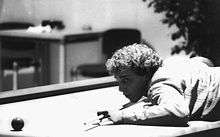One-cushion carom
One-cushion billiards, also known as cushion carom billiards,[1] and historically as the indirect game,[2] is a carom billiards discipline generally played on a cloth-covered, 10-by-5-foot (3.0 m × 1.5 m), pocketless table with two cue balls and a third red-colored ball.[3] In a one-cushion shot, the cue ball caroms off of both object balls with at least one rail being struck before the hit on the second object ball. The object of the game is to score up to an agreed upon number of cushion caroms, with one point being awarded for each successfully made. If no object ball is contacted, one point is deducted. If there is ambiguity as to whether the second ball was contacted, it is resolved against the shooter.[3][4] It is governed by the Union Mondiale de Billard, the world governing body of carom billiards.[5][6]
 Marco Zanetti at the 1986 Einband-Europameisterschaft | |
| Characteristics | |
|---|---|
| Contact | No |
| Team members | Individual |
| Type | Cue sports |
| Equipment | Cue stick, billiard balls, billiard table |
| Venue | Billiard hall |
| Presence | |
| Olympic | No |
| Paralympic | No |
History
One-cushion carom developed in the late 1860s as an alternative to the game straight rail, in which points are scored by a simple carom off both object balls with no cushion requirement. Straight rail fell into disfavor as skilled top players could score a seemingly endless series of points with the balls barely moving in a confined area of the table playing area. This was a result of the "rail nurse", a shot in which the object balls are nudged at very soft speed down a rail to a duplicate position again and again.[3][4] The solution was to require that all shots include contact with at least one cushion before the second object ball is contacted, an idea taken from an early form of English billiards called the doublet game. [3][7][8] Later, between 1881 and 1889, a new nurse shot was developed for one-cushion, known as the "rub nurse". With the two object balls stacked perpendicular to a rail and just next to it, the rub nurse is performed by gently banking the cue ball off the rail just before them resulting in a soft graze of both and the same or near the same position repeating.[3]
By the late 1870s, the newer discipline of balkline increasingly becoming effective at limited nursing. It eclipsed one-cushion caroms as the game of public match play and tournaments until well into the 20th century.[3] One-cushion caroms retain some popularity with the public; it is known that Mark Twain enjoyed the game on occasion.[3][9][10] The presently-dominant game, three-cushion billiards, a direct outgrowth of one-cushion carom also beginning in the 1870s, did not marginalize balkline until the 1920s.
The U.S. title at one-cushion caroms has only been held by six men: Joseph Dion, William Sexton, Maurice Daly, George Slosson and Willie Hoppe, who held it for 11 years from 1933 to 1944. Today, one-cushion caroms is rarely played in the U.S., but it still enjoys some popularity in Europe where it is featured as one of the five games making up the annual billiards pentathlons, the other four games being 47.1 balkline, straight rail, 71.2 balkline and three-cushion billiards.[3]
References
- "Saw Good Billiards: Union Leaguers Entertained by Four Star Cue-wielders". Brooklyn Daily Eagle. Brooklyn, NY: 8. December 20, 1893. Archived from the original on June 12, 2011. Retrieved 2008-08-19.
- New York Times Company (October 28, 1888). Drawbacks to Billiards; Personal Solicitude the Source of Nearly All. Lost Professional Pride and Pluck Both Evades Public Matches and Suppresses Them. Retrieved January 2, 2007.
- Shamos, Michael Ian (1993). The Illustrated Encyclopedia of Billiards. New York, NY: Lyons & Burford. pp. 15, 72, 82, 196 and 232–3. ISBN 1-55821-219-1.
- Hoyle, Edmond (1907). Hoyle's Games - Autograph Edition. New York: A. L. Burt Company. p. 41.
- Union Mondiale de Billard Tournament Rules. Retrieved 14 April 2019.
- World Rules of Carom Billiards. Retrieved 14 April 2019.
- White and Bohn, exact date unknown (1850). The Billiard Player's Hand book. Philadelphia: Henry F. Anners. p. 38.
- Maxwell, William Hamilton (1833). The field book; or, Sports and pastimes of the British islands. London: Effingham Wilson. p. 46.
- Paine, Albert Bigelow (1912). Mark Twain: the personal and literary life of Samuel Langhorne Clemens. New York, London: Harper & Brothers. p. 1427.
- Twain, Mark (1967). Hamlin Hill (ed.). Mark Twain's Letters to His Publishers, 1867-1894. Berkeley: University of California Press. p. 168. ISBN 0-520-00560-0.
